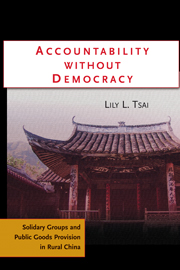Book contents
- Frontmatter
- Contents
- List of Figures
- List of Tables
- Acknowledgments
- 1 GOVERNANCE AND INFORMAL INSTITUTIONS OF ACCOUNTABILITY
- 2 DECENTRALIZATION AND LOCAL GOVERNMENTAL PERFORMANCE
- 3 LOCAL GOVERNMENTAL PERFORMANCE
- 4 INFORMAL ACCOUNTABILITY AND THE STRUCTURE OF SOLIDARY GROUPS
- 5 TEMPLES AND CHURCHES IN RURAL CHINA
- 6 LINEAGES AND LOCAL GOVERNANCE
- 7 ACCOUNTABILITY AND VILLAGE DEMOCRATIC REFORMS
- 8 THE LIMITATIONS OF FORMAL PARTY AND BUREAUCRATIC INSTITUTIONS
- 9 CONCLUSION
- References
- Appendix: Additional Notes on Survey Sampling and Data Analysis
- Index
- Cambridge Studies in Comparative Politics
5 - TEMPLES AND CHURCHES IN RURAL CHINA
Published online by Cambridge University Press: 05 June 2012
- Frontmatter
- Contents
- List of Figures
- List of Tables
- Acknowledgments
- 1 GOVERNANCE AND INFORMAL INSTITUTIONS OF ACCOUNTABILITY
- 2 DECENTRALIZATION AND LOCAL GOVERNMENTAL PERFORMANCE
- 3 LOCAL GOVERNMENTAL PERFORMANCE
- 4 INFORMAL ACCOUNTABILITY AND THE STRUCTURE OF SOLIDARY GROUPS
- 5 TEMPLES AND CHURCHES IN RURAL CHINA
- 6 LINEAGES AND LOCAL GOVERNANCE
- 7 ACCOUNTABILITY AND VILLAGE DEMOCRATIC REFORMS
- 8 THE LIMITATIONS OF FORMAL PARTY AND BUREAUCRATIC INSTITUTIONS
- 9 CONCLUSION
- References
- Appendix: Additional Notes on Survey Sampling and Data Analysis
- Index
- Cambridge Studies in Comparative Politics
Summary
The model of informal accountability hypothesizes that in political systems with weak formal institutions of accountability, localities with encompassing and embedding solidary groups are likely to have better local governmental provision of public goods than localities without these groups, all other things being equal. To evaluate the plausibility of this hypothesis, this chapter derives its observable implications for two types of solidary groups common in rural China: village temples and village churches. If the hypothesis is correct, we should expect that village temples, which are usually encompassing and embedding, will be more likely to have a positive effect on village governmental provision of public goods. Village churches, on the other hand, are encompassing but not embedding, so they should be less likely to have a positive effect on village governmental provision of public goods.
The Structure of Temples and Churches in Rural China
As with most rural solidary groups, the state tolerates the existence of village temples and village churches as long as they limit their activities to the boundaries of the village. Within the village, temples and churches are typically open to everyone, temples because they have a strong historical association as symbols of the village community as a whole and churches because the forms of Christianity that are practiced in rural China are generally inclusive of and welcoming to new adherents. Thus, village temples and village churches are both generally encompassing solidary groups.
- Type
- Chapter
- Information
- Accountability without DemocracySolidary Groups and Public Goods Provision in Rural China, pp. 120 - 147Publisher: Cambridge University PressPrint publication year: 2007



